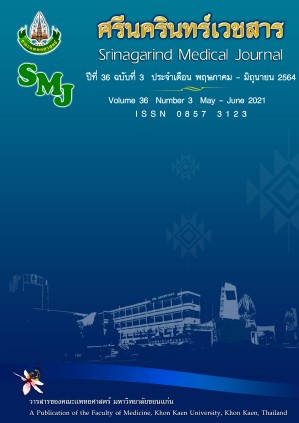ผลของการออกกำลังกายด้วยตารางเก้าช่องต่อการทรงตัวของผู้สูงอายุที่มีความเสี่ยงต่อการหกล้ม
Abstract
บทคัดย่อ
หลักการและวัตถุประสงค์: ปัจจุบันการออกกำลังกายด้วยตารางเก้าช่องเป็นที่แพร่หลายในชุมชน แต่ผลต่อการทรงตัวของผู้สูงอายุยังไม่ชัดเจน การศึกษานี้มีวัตถุประสงค์เพื่อประเมินผลของการออกกำลังกายด้วยตารางเก้าช่องต่อการทรงตัวของผู้สูงอายุที่มีความเสี่ยงต่อการหกล้ม
วิธีการศึกษา: ผู้สูงอายุจำนวน 34 ราย (อายุเฉลี่ย 63.8±2.0 ปี) ถูกแบ่งเป็นกลุ่มทดลองและกลุ่มควบคุม (กลุ่มละ 17 ราย) กลุ่มทดลองได้รับการฝึกออกกำลังกายด้วยตารางเก้าช่อง 3 วันต่อสัปดาห์ วันละ 30 นาที เป็นเวลา 5 สัปดาห์ กลุ่มควบคุมได้รับการอบรมความรู้ในสัปดาห์ที่ 2 และ 4 ของการศึกษา ประเมินการทรงตัวขณะเคลื่อนไหวและยืนนิ่งของอาสาสมัครเมื่อก่อนและหลังการศึกษาด้วย Timed Up and Go Test (TUGT) และ One Leg Stance Test (OLST) ตามลำดับ วิเคราะห์ผลการศึกษาด้วยสถิติ T-tests
ผลการศึกษา: เมื่อสิ้นสุดการศึกษา กลุ่มทดลองมีการทรงตัวดีขึ้นอย่างมีนัยสำคัญทางสถิติ (p<0.05) และเมื่อเปรียบเทียบระหว่างกลุ่มพบว่ากลุ่มทดลองใช้เวลาในการทำ TUGT น้อยกว่ากลุ่มควบคุมอย่างมีนัยสำคัญทางสถิติ (p<0.001) แต่ผลการทำ OLST ของทั้ง 2 กลุ่มแตกต่างกันอย่างไม่มีนัยสำคัญทางสถิติ (p>0.10)
สรุป: การออกกำลังกายด้วยตารางเก้าช่องช่วยเพิ่มการทรงตัวขณะเคลื่อนไหวของผู้สูงอายุที่มีความเสี่ยงต่อการหกล้มได้ จึงอาจเป็นทางเลือกหนึ่งสำหรับการพัฒนาการทรงตัวของผู้สูงอายุในชุมชน
คำสำคัญ: ผู้สูงอายุ; การออกกำลังกาย; การทรงตัว; หกล้ม
Background and objective: Presently, “nine-square exercise” is popular among community-dwellers in Thailand. However, evidences in the benefits of nine-square exercise on balance in older persons remained unclear. This study aimed to evaluate the effects of nine-square exercise on balance in the elderly with falls risk.
Methods: Thirty-four older persons (mean age 63.8±2.0 years) were divided into experimental and control groups (17 of each). The experimental group was assigned to practice nine-square exercise for 3 days/week, 30 minutes/day for a total of 5 weeks, while the control group attended health education classes at weeks 2 and 4 of the study. At pre- and post-study, all participants were evaluated for dynamic and static balance by using the Timed Up and Go Test (TUGT) and the One Leg Stance Test (OLST), respectively. Data were analyzed by using the T-tests.
Results: At the end of the study, the experimental group significantly improved their balance (p<0.05). When compared between groups, the experimental group showed significantly less time taken to complete the TUGT than did the control group (p<0.001). No statistically significant difference between groups was found in the OLST (p>0.10).
Conclusions: Nine-square exercise could improve dynamic balance in the elderly with falls risk. Therefore, this exercise is possibly an alternative exercise regimen for improving balance in community-dwelling older persons.
Keywords: elderly; exercise; balance; falls


